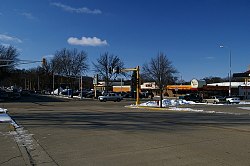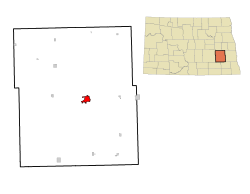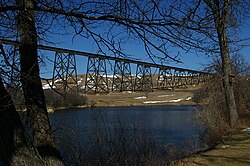City in North Dakota, United States
| Valley City, North Dakota | |
|---|---|
| City | |
 Central Ave and Main Street in Valley City Central Ave and Main Street in Valley City | |
| [REDACTED] | |
| Motto: "City of Bridges" | |
 Location of Valley City, North Dakota Location of Valley City, North Dakota | |
| Coordinates: 46°55′23.93″N 98°00′11.36″W / 46.9233139°N 98.0031556°W / 46.9233139; -98.0031556 | |
| Country | United States |
| State | North Dakota |
| County | Barnes |
| Founded | 1872 |
| Established | 1874 |
| Incorporated (village) | 1881 |
| Incorporated (city) | 1883 |
| Government | |
| • Mayor | Dave Carlsrud (D) |
| Area | |
| • City | 4.300 sq mi (11.14 km) |
| • Land | 4.296 sq mi (11.13 km) |
| • Water | 0.004 sq mi (0.010 km) |
| Elevation | 1,221 ft (372 m) |
| Population | |
| • City | 6,575 |
| • Estimate | 6,551 |
| • Density | 1,524.99/sq mi (588.81/km) |
| • Urban | 6,547 |
| • Metro | 10,726 |
| Time zone | UTC–6 (Central (CST)) |
| • Summer (DST) | UTC–5 (CDT) |
| ZIP Code | 58072 |
| Area code | 701 |
| FIPS code | 38-81180 |
| GNIS feature ID | 1032618 |
| Highways | I-94, I-94 Bus. |
| Sales tax | 7.5% |
| Website | valleycity.us |
Valley City is a city in and the county seat of Barnes County, North Dakota, United States. The population was 6,575 at the 2020 census, making it the 12th most populous city in North Dakota. Valley City was founded in 1874.
Valley City is known for its many bridges over the Sheyenne River, including the Hi-Line Railroad Bridge. These bridges have earned it the nickname "City of Bridges". The city is also the home of Valley City State University and the North Dakota High School Activities Association (NDHSAA).
History
Valley City was established in 1874 with the building of a railroad station. The town was originally named Worthington after the town's promoter, George Worthington. The present name is for the city's location in the valley of the Sheyenne River. A post office was established under the name Worthington in 1874, and has continued to operate under the name Valley City since 1878. A Carnegie Library opened in 1903 through the efforts of the "Tuesday Club," a local women's organization. The inception of the nation's first barber association occurred in Valley City during a state barber convention in February, 1909.
Geography
Valley City is located at 46°55′23.93″N 98°00′11.36″W / 46.9233139°N 98.0031556°W / 46.9233139; -98.0031556 (46.9233129, -98.0031547).
According to the United States Census Bureau, the city has a total area of 4.300 square miles (11.14 km), of which 4.296 square miles (11.13 km) is land and 0.004 square miles (0.01 km) is water.
Demographics
| Census | Pop. | Note | %± |
|---|---|---|---|
| 1880 | 302 | — | |
| 1890 | 1,089 | 260.6% | |
| 1900 | 2,446 | 124.6% | |
| 1910 | 4,606 | 88.3% | |
| 1920 | 4,686 | 1.7% | |
| 1930 | 5,268 | 12.4% | |
| 1940 | 5,917 | 12.3% | |
| 1950 | 6,851 | 15.8% | |
| 1960 | 7,809 | 14.0% | |
| 1970 | 7,843 | 0.4% | |
| 1980 | 7,774 | −0.9% | |
| 1990 | 7,163 | −7.9% | |
| 2000 | 6,826 | −4.7% | |
| 2010 | 6,585 | −3.5% | |
| 2020 | 6,575 | −0.2% | |
| 2023 (est.) | 6,551 | −0.4% | |
| U.S. Decennial Census 2020 Census | |||
As of the 2022 American Community Survey, there are 3,039 estimated households in Valley City with an average of 1.96 persons per household. The city has a median household income of $52,224. Approximately 16.4% of the city's population lives at or below the poverty line. Valley City has an estimated 63.9% employment rate, with 28.9% of the population holding a bachelor's degree or higher and 94.3% holding a high school diploma.
The top five reported ancestries (people were allowed to report up to two ancestries, thus the figures will generally add to more than 100%) were English (95.4%), Spanish (0.7%), Indo-European (1.5%), Asian and Pacific Islander (2.0%), and Other (0.4%).
The median age in the city was 39.1 years.
2020 census
| Race / ethnicity (NH = non-Hispanic) | Pop. 2000 | Pop. 2010 | Pop. 2020 | % 2000 | % 2010 | % 2020 |
|---|---|---|---|---|---|---|
| White alone (NH) | 6,603 | 6,214 | 5,890 | 96.73% | 94.37% | 89.58% |
| Black or African American alone (NH) | 50 | 79 | 173 | 0.73% | 1.20% | 2.63% |
| Native American or Alaska Native alone (NH) | 51 | 47 | 71 | 0.75% | 0.71% | 1.08% |
| Asian alone (NH) | 19 | 54 | 67 | 0.28% | 0.82% | 1.02% |
| Pacific Islander alone (NH) | 0 | 1 | 2 | 0.00% | 0.02% | 0.03% |
| Other race alone (NH) | 2 | 0 | 15 | 0.03% | 0.00% | 0.23% |
| Mixed race or multiracial (NH) | 45 | 94 | 211 | 0.66% | 1.43% | 3.21% |
| Hispanic or Latino (any race) | 56 | 96 | 146 | 0.82% | 1.46% | 2.22% |
| Total | 6,826 | 6,585 | 6,575 | 100.00% | 100.00% | 100.00% |
As of the 2020 census, there were 6,575 people, 2,966 households, and 1,454 families residing in the city. The population density was 1,581.3 inhabitants per square mile (610.5/km). There were 3,391 housing units at an average density of 815.5 per square mile (314.9/km). The racial makeup of the city was 90.22% White, 2.77% African American, 1.19% Native American, 1.02% Asian, 0.05% Pacific Islander, 0.96% from some other races and 3.80% from two or more races. Hispanic or Latino people of any race were 2.22% of the population. 21.2% of residents were under the age of 18, 5.1% were under 5 years of age, and 20.6% were 65 and older. The gender makeup of the city was 50.3% male and 49.7% female.
2010 census
As of the 2010 census, there were 6,585 people, 2,986 households, and 1,563 families living in the city. The population density was 1,903.5 inhabitants per square mile (734.9/km). There were 3,307 housing units at an average density of 955.8 per square mile (369.0/km). The racial makeup of the city was 95.22% White, 1.25% African American, 0.73% Native American, 0.82% Asian, 0.03% Pacific Islander, 0.24% from some other races and 1.72% from two or more races. Hispanic or Latino people of any race were 1.46% of the population.
Of the 2,986 households 22.6% had children under the age of 18 living with them, 41.1% were married couples living together, 7.9% had a female householder with no husband present, 3.3% had a male householder with no wife present, and 47.7% were non-families. 39.4% of households were one person and 17.9% were one person aged 65 or older. The average household size was 2.04 and the average family size was 2.74.
The median age was 42.1 years. 18.7% of residents were under the age of 18; 13.2% were between the ages of 18 and 24; 21.1% were from 25 to 44; 24.9% were from 45 to 64; and 22.0% were 65 or older. The gender makeup of the city was 48.1% male and 51.9% female.
2000 census
As of the 2000 census, there were 6,826 people, 2,996 households, and 1,668 families living in the city. The population density was 2,062.5 inhabitants per square mile (796.3/km). There were 3,250 housing units at an average density of 982.0 per square mile (379.2/km). The racial makeup of the city was 97.39% White, 0.73% African American, 0.75% Native American, 0.28% Asian, 0.00% Pacific Islander, 0.19% from some other races and 0.66% from two or more races. Hispanic or Latino people of any race were 0.82% of the population.
The top six ancestry groups in the city are German (45.5%), Norwegian (38.8%), Irish (9.1%), Swedish (5.2%), French (4.8%), English (3.8%).
Of the 2,996 households 23.3% had children under the age of 18 living with them, 44.6% were married couples living together, 8.1% had a female householder with no husband present, and 44.3% were non-families. 38.3% of households were one person and 19.6% were one person aged 65 or older. The average household size was 2.09 and the average family size was 2.77.
The age distribution was 18.8% under the age of 18, 15.3% from 18 to 24, 21.4% from 25 to 44, 21.4% from 45 to 64, and 23.1% 65 or older. The median age was 41 years. For every 100 females, there were 89.4 males. For every 100 females age 18 and over, there were 87.5 males.
The median household income was $28,050 and the median family income was $41,604. Males had a median income of $30,035 versus $17,667 for females. The per capita income for the city was $16,257. About 5.5% of families and 12.4% of the population were below the poverty line, including 11.9% of those under age 18 and 12.8% of those age 65 or over.
Local media
AM radio
| AM radio stations | |||||
|---|---|---|---|---|---|
| Frequency | Call sign | Name | Format | Owner | City of license |
| 1490 AM | KOVC | The Voice of the Valley KOVC | Full Service/Country | i3G Media | Valley City |
FM radio
| FM radio stations | ||||||
|---|---|---|---|---|---|---|
| Frequency | Call sign | Name | Format | Owner | City of license | |
| 96.3 FM | K242CZ | The Voice of the Valley KOVC | Full Service/Country KOVC translator |
i3G Media | Valley City | |
| 102.7 FM | K274BH | Ted FM | Adult Contemporary KRVX-HD2 translator |
i3G Media | Valley City | |
- CSiCable
The local newspaper is the Valley City Times-Record.
Education
K–12
Valley City is served by the Valley City Public School District which consists of Jefferson Elementary School, Washington Elementary School, Valley City Christian School, and Valley City Junior/Senior High School. St. Catherine's Catholic School for grade K–6 also serves students in Valley City.
Higher education
Sites of interest

- Hi-Line Railroad Bridge
- North Dakota Winter Show
- North Country Trail
- The Rosebud Visitor Center contains a restored railway passenger car.

Transportation
Intercity bus service to the city is provided by Jefferson Lines. Local dial-a-ride transit is provided by South Central Transit which operates on weekdays from 8am to 5pm and weekends from 8am to 2pm for a $2 fare.
Valley City Parks and Recreation operates a bikeshare system with a single station located at the Gaukler Family Wellness Center.
Notable people
- Jeff Boschee, former professional basketball player and current head coach at Pittsburgh State
- Paul Fjelde, sculptor; professor at Pratt Institute
- John E. Grotberg, congressman
- Peggy Lee, jazz and popular music singer, songwriter, composer, and actress
- George W. Mason, chairman and CEO of Kelvinator and American Motors Company
- James M. McPherson, Civil War historian; Pulitzer Prize winner
- Gerhard Brandt Naeseth, genealogist; founder of the Norwegian-American Genealogical Center & Naeseth Library
- Earl Pomeroy, congressman
- Ann Sothern, film and TV actress with two stars on the Hollywood Walk of Fame
- Herman Stern, proprietor of Straus Clothing, businessman, humanitarian, social and economic activist
- Tyrell Terry, professional basketball player
- Carol Thurston, actress
- Frank White, eighth governor of North Dakota and treasurer of the United States (1921–1928)
- Michael Wobbema, member of the North Dakota Senate
- George M. Young, congressman, judge
Climate
This climatic region is typified by large seasonal temperature differences, with warm to hot (and often humid) summers and cold (sometimes severely cold) winters. According to the Köppen Climate Classification system Valley City has a humid continental climate, abbreviated "Dfb" on climate maps.
References
- ^ "2024 U.S. Gazetteer Files". United States Census Bureau. Retrieved November 29, 2024.
- "2020 Census Qualifying Urban Areas and Final Criteria Clarifications". Federal Register. United States Census Bureau. December 29, 2022.
- ^ U.S. Geological Survey Geographic Names Information System: Valley City, North Dakota
- ^ "Explore Census Data". United States Census Bureau. Retrieved October 13, 2023.
- ^ "City and Town Population Totals: 2020–2023". United States Census Bureau. November 29, 2024. Retrieved November 29, 2024.
- "Valley City (ND) sales tax rate". Retrieved November 29, 2024.
- "Find a County". National Association of Counties. Retrieved June 7, 2011.
- North Dakota: Counties, Towns and People. Watchmaker Publishing, Ltd. 2008. p. 14. ISBN 978-1-60386-115-1.
- Federal Writers' Project (1938). North Dakota, a Guide to the Northern Prairie State. WPA. p. 280. ISBN 978-1-62376-033-5.
- "Barnes County". Jim Forte Postal History. Retrieved October 22, 2015.
- "About us". www.vcbclibrary.org. Retrieved February 16, 2017.
- "Tuesday Club Credited for Start of Library in Valley City". barnescountyhistoricalsociety. May 11, 2011. Retrieved February 16, 2017.
- Jackson, William (2008). Almanac of North Dakota mysteries & oddities, 2009-2010. Valley Star Books. p. 16. ISBN 9780967734989. OCLC 259419005.
- "Census of Population and Housing". United States Census Bureau. Retrieved June 4, 2015.
- "U.S. Census Bureau QuickFacts: Valley City city, Washington". www.census.gov. Retrieved November 29, 2024.
- "P004: Hispanic or Latino, and Not Hispanic or Latino by Race – 2000: DEC Summary File 1 – Valley City city, North Dakota". United States Census Bureau. Retrieved November 29, 2024.
- "P2: Hispanic or Latino, and Not Hispanic or Latino by Race – 2010: DEC Redistricting Data (PL 94-171) – Valley City city, North Dakota". United States Census Bureau. Retrieved November 29, 2024.
- "P2: Hispanic or Latino, and Not Hispanic or Latino by Race – 2020: DEC Redistricting Data (PL 94-171) – Valley City city, North Dakota". United States Census Bureau. Retrieved November 29, 2024.
- "US Census Bureau, Table P16: Household Type". United States Census Bureau. Retrieved November 29, 2024.
- "How many people live in Valley City city, North Dakota". USA Today. Retrieved November 29, 2024.
- Jackson, William (2021). Dakota Mysteries & Oddities, 2022 Edition. Dickinson, ND: Valley Star Publishing. pp. 43–44. ISBN 978-0-9677349-9-6.
- "North Dakota Bus Stops". Retrieved July 20, 2023.
- "South Central Transit-Barnes County". Retrieved July 12, 2024.
- "VC Parks Rentals". Retrieved July 12, 2024.
- Climate Summary for Valley City, North Dakota
External links
- City of Valley City – official website
- Visit Valley City Tourism – Rosebud Visitor Center
- Community data for industry: Valley City, North Dakota (1980) from the Digital Horizons website
| Places adjacent to Valley City, North Dakota | ||||||||||||||||
|---|---|---|---|---|---|---|---|---|---|---|---|---|---|---|---|---|
| ||||||||||||||||
| Municipalities and communities of Barnes County, North Dakota, United States | ||
|---|---|---|
| County seat: Valley City | ||
| Cities |  | |
| Townships |
| |
| Unincorporated communities | ||
| Footnotes | ‡This populated place also has portions in an adjacent county or counties | |
